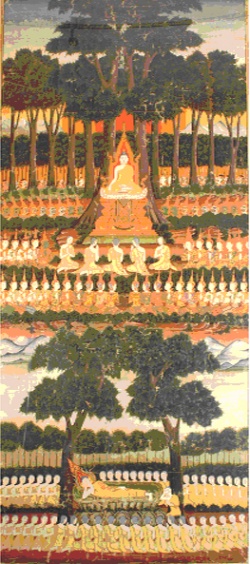Parinirvana
In Buddhism, parinirvana (Sanskrit: परिनिर्वाण Parinirvāṇa; Pali: परिनिब्बान parinibbāna; Chinese: 般涅槃, bān niè pán) is the final Nirvana, which occurs upon the Death of the Body of someone who has attained complete Awakening (Bodhi).
It implies a release from the bhavachakra, Saṃsāra, Karma and Rebirth as well as the dissolution of the Skandhas. Parinirvana The Buddha's final Nirvana, entered by him at the time of death.
The parinibbana of The Buddha is described in the Mahāparinibbāna Sutta.
Because of its attention to detail, the Mahaparinibbana Sutta (of the Theravada tradition), though first committed to Writing hundreds of years after his Death, has been resorted to as the principal source of reference in most standard studies of The Buddha's Life.
In some Mahayana scriptures (notably the Mahayana Mahaparinirvana Sutra), Parinirvana is explicated as the realm of the eternal true Self of The Buddha.
Accounts
Accounts of the purported events surrounding The Buddha's own Parinirvāṇa are found in a wide range of Buddhist canonical literature.
In addition to the Pāli Mahāparinibbāna Sutta (DN 16) and its Sanskrit parallels, the topic is treated in the Saṃyutta-Nikāya (SN 6.15) and the several Sanskrit parallels (T99 p253c-254c), the Sanskrit-based Ekottara-āgama (T125 p750c), and other early sutras preserved in Chinese, as well as in most of the Vinayas preserved in Chinese of the early Buddhist schools such as the Sarvāstivādins and the Mahāsāṅghikas.
The historical event of The Buddha's Parinirvāṇa is also described in a number of later works, such as the Sanskrit Buddha-carita and the Avadāna-śataka, and the Pāli Mahāvaṃsa.
According to Bareau, the oldest core components of all these accounts are just the account of The Buddha's Parinirvāṇa itself at Kuśinagara and the funerary rites following his Death.
He deems all other extended details to be later additions with little historical value.
In contrast to these works which deal with The Buddha's Parinirvāṇa as a biographical event, the Mahāyāna Mahā Parinirvāṇa Mahā-Sūtra, which bears a similar name, was written hundreds of years later.
The Nirvana Sutra does not give details of the historical event of the day of the Parinirvāṇa itself, except
The Buddha's illness and Cunda's meal Offering, nor any of the other preceding or subsequent incidents, instead using the event as merely a convenient springboard for the expression of standard Mahayana ideals such as the Tathagata-garbha/ Buddha-dhatu Doctrine, the eternality of The Buddha, and the soteriological Fate of the icchantikas and so forth.
In Mahayana literature
According to the Mahayana Mahaparinirvana Mahā-Sūtra (also called the Nirvana Sutra), The Buddha taught that parinirvana is the realm of the Eternal, Bliss, the Self, and the Pure. Dr. Paul Williams states that it depicts The Buddha using the term "Self" in order to win over non-Buddhist ascetics.
However, the Mahaparinirvana Sutra is a long and highly composite Mahayana scripture, and the part of the Sutra upon which Williams is basing his statement is a portion of the Nirvana Sutra of secondary Central Asian provenance - other parts of the Sutra were written in India.
Guang Xing speaks of how the Mahayanists of the Nirvana Sutra understand the mahaparinirvana to be the liberated Self of the Eternal Buddha:
- One of the main themes of the MMPS Mahayana Mahaparinirvana Sutra is that The Buddha is eternal ... The Mahayanists assert the eternity of The Buddha in two ways in the MMPS. They state that The Buddha is the Dharmakaya, and hence eternal. Next, they reinterpret the Liberation of The Buddha as mahaparinirvana possessing four attributes: eternity, Happiness, self and purity.
Only in Mahaparinirvana is this True Self held to be fully discernible and accessible.
Kosho Yamamoto cites a passage in which The Buddha admonishes his Monks not to dwell inordinately on the idea of the non-Self but to meditate on the Self. Dr. Yamamoto writes:
- Having dwelt upon the nature of Nirvana, The Buddha now explains its positive aspect and says that Nirvana has the four attributes of the Eternal, Bliss, the Self, and the Pure ... The Buddha says: "O you bhiksus monks! Do not abide in the Thought of the non-eternal, sorrow, non-Self, and the not-pure and have things as in the case of those people who take the stones, wooden pieces and gravel for the true gem [of the true Dharma... In every situation, constantly meditate upon the idea of the Self, the idea of the Eternal, Bliss, and the Pure ... Those who, desirous of attaining Reality meditatively cultivate these ideas, namely, the ideas of the Self atman, the Eternal, Bliss, and the Pure, will skilfully bring forth the jewel, just like the wise person."
Michael Zimmermann, in his study of the Tathagatagarbha Sutra, reveals that not only the Mahaparinirvana Sutra but also the Tathagatagarbha Sutra and The Lankavatara Sutra speak affirmatively of the Self. Zimmermann observes:
- the existence of an eternal, imperishable self, that is, Buddhahood, is definitely the basic point of the TGS Tathagatagarbha Sutra ... the Mahaparinirvanasutra and the Lankavatarasutra characterize the Tathagatagarbha explicitly as Atman Self.
See also: Parinirvāṇa

